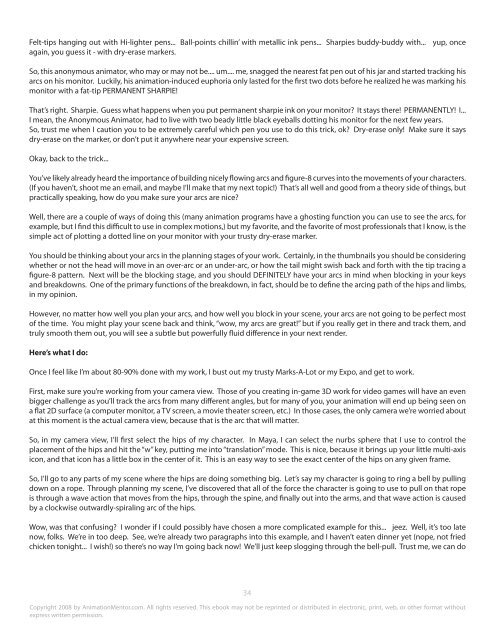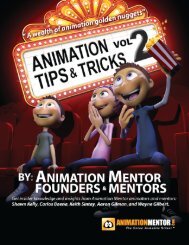TRACK YOUR ARCSOkay, before I get started this month, I just wanted to take a second to thank all the people who wrote in with comments, ideas,thoughts, jokes, etc. It was a kick to hear from you, and honestly, kind of weird (but exciting!) to find out that people other than mygirlfriend and my Mom actually read this article!From here on out, feel free to continue to hit me up with any thoughts at: tipsandtricks@animationmentor.comA lot of the feedback I got was very positive in terms of last month’s deviation into the world of practical “tricks,” which seems to havebeen a particularly nice diversion after so many months of sometimes intangible animation theory.In light of that, how about another trick?I’m kind of torn, here, between feeling like a lot of the tricks that spring to mind are commonly known among animators, andthinking that there are also a lot of newer animators out there reading this article who may not have already been to animationschool.Last month’s “hide the legs” trick was pretty advanced (again, I wouldn’t recommend trying that method until you’ve animated for acouple of years or so at least,) so this month let’s give you newer folks something easier (but not less helpful) to try!TRICK #2: Track Your Arcs!!I’m sure many of you have already discovered the fantastic combination of dry-erase markers and your monitor. Like peanut butter& jelly, prosciutto & melon, and fried chicken & my taste buds, these are two things that were destined to make a great team.For the rest of you, the trick is this: use a dry-erase marker (such as the ubiquitous “Sanford EXPO” or an “Avery Marks-A-Lot”) to trackyour arcs, through time and space, by tracing the movement of your character across your screen.Now, before we go any further, let me quickly touch on a ***VERY IMPORTANT*** difference between a “dry-erase marker,” whichare traditionally used to draw on white-boards and are easily wiped away, and a Sharpie, which is traditionally used as a nonsmearingpermanent marker.Dry-erase markers are, as their name implies, easily erased.Permanent markers, such as Sharpies, are.... yup, you guessed it! Permanent!It may sound like common sense to you that one would work well drawing on your computer monitor, and one wouldn’t.Well, I think it’s important to talk about anyway, because I happen to know of an animator, who will remain nameless but may ormay not write a monthly “<strong>Animation</strong> <strong>Tips</strong> & <strong>Tricks</strong>” article for the newsletter of a certain online animation school, who got a little toocaught up in the excitement of polishing up one of his shots one night at home. This Anonymous Animator, who may or may notlove fried chicken, intelligently kept all of his pens in one jar on his desk (smart, huh?).33Copyright 2008 by <strong>Animation</strong><strong>Mentor</strong>.com. All rights reserved. This ebook may not be reprinted or distributed in electronic, print, web, or other format withoutexpress written permission.
Felt-tips hanging out with Hi-lighter pens... Ball-points chillin’ with metallic ink pens... Sharpies buddy-buddy with... yup, onceagain, you guess it - with dry-erase markers.So, this anonymous animator, who may or may not be.... um.... me, snagged the nearest fat pen out of his jar and started tracking hisarcs on his monitor. Luckily, his animation-induced euphoria only lasted for the first two dots before he realized he was marking hismonitor with a fat-tip PERMANENT SHARPIE!That’s right. Sharpie. Guess what happens when you put permanent sharpie ink on your monitor? It stays there! PERMANENTLY! I...I mean, the Anonymous Animator, had to live with two beady little black eyeballs dotting his monitor for the next few years.So, trust me when I caution you to be extremely careful which pen you use to do this trick, ok? Dry-erase only! Make sure it saysdry-erase on the marker, or don’t put it anywhere near your expensive screen.Okay, back to the trick...You’ve likely already heard the importance of building nicely flowing arcs and figure-8 curves into the movements of your characters.(If you haven’t, shoot me an email, and maybe I’ll make that my next topic!) That’s all well and good from a theory side of things, butpractically speaking, how do you make sure your arcs are nice?Well, there are a couple of ways of doing this (many animation programs have a ghosting function you can use to see the arcs, forexample, but I find this difficult to use in complex motions,) but my favorite, and the favorite of most professionals that I know, is thesimple act of plotting a dotted line on your monitor with your trusty dry-erase marker.You should be thinking about your arcs in the planning stages of your work. Certainly, in the thumbnails you should be consideringwhether or not the head will move in an over-arc or an under-arc, or how the tail might swish back and forth with the tip tracing afigure-8 pattern. Next will be the blocking stage, and you should DEFINITELY have your arcs in mind when blocking in your keysand breakdowns. One of the primary functions of the breakdown, in fact, should be to define the arcing path of the hips and limbs,in my opinion.However, no matter how well you plan your arcs, and how well you block in your scene, your arcs are not going to be perfect mostof the time. You might play your scene back and think, “wow, my arcs are great!” but if you really get in there and track them, andtruly smooth them out, you will see a subtle but powerfully fluid difference in your next render.Here’s what I do:Once I feel like I’m about 80-90% done with my work, I bust out my trusty Marks-A-Lot or my Expo, and get to work.First, make sure you’re working from your camera view. Those of you creating in-game 3D work for video games will have an evenbigger challenge as you’ll track the arcs from many different angles, but for many of you, your animation will end up being seen ona flat 2D surface (a computer monitor, a TV screen, a movie theater screen, etc.) In those cases, the only camera we’re worried aboutat this moment is the actual camera view, because that is the arc that will matter.So, in my camera view, I’ll first select the hips of my character. In Maya, I can select the nurbs sphere that I use to control theplacement of the hips and hit the “w” key, putting me into “translation” mode. This is nice, because it brings up your little multi-axisicon, and that icon has a little box in the center of it. This is an easy way to see the exact center of the hips on any given frame.So, I’ll go to any parts of my scene where the hips are doing something big. Let’s say my character is going to ring a bell by pullingdown on a rope. Through planning my scene, I’ve discovered that all of the force the character is going to use to pull on that ropeis through a wave action that moves from the hips, through the spine, and finally out into the arms, and that wave action is causedby a clockwise outwardly-spiraling arc of the hips.Wow, was that confusing? I wonder if I could possibly have chosen a more complicated example for this... jeez. Well, it’s too latenow, folks. We’re in too deep. See, we’re already two paragraphs into this example, and I haven’t eaten dinner yet (nope, not friedchicken tonight... I wish!) so there’s no way I’m going back now! We’ll just keep slogging through the bell-pull. Trust me, we can do34Copyright 2008 by <strong>Animation</strong><strong>Mentor</strong>.com. All rights reserved. This ebook may not be reprinted or distributed in electronic, print, web, or other format withoutexpress written permission.
- Page 2 and 3: Animation Tips & TricksBY: Shawn Ke
- Page 4 and 5: INTRODUCTIONWelcome to the First Ed
- Page 6 and 7: FOUNDERS BIOSBobby BeckBobby was an
- Page 8 and 9: TESTIMONIALS“Three things come to
- Page 10 and 11: PLANNINGBecause this is the first a
- Page 12 and 13: REFERENCE MATERIALSWe've been talki
- Page 14 and 15: THUMBNAILSWelcome back!This month w
- Page 16 and 17: BLINKS HAVE MEANINGTip 1: Blinks Ha
- Page 18 and 19: Then a thought occurs to him: “is
- Page 20 and 21: has his shovel in hand. His eyes ar
- Page 22 and 23: THE FACEHey there animators! Welcom
- Page 24 and 25: OPERATIVE WORDSHello Animators!Welc
- Page 26 and 27: So, to make a long story short - ch
- Page 28 and 29: Well, for one thing, you want to sp
- Page 30 and 31: KEEP SECONDARY CHARACTERS SECONDARY
- Page 32 and 33: might glance at him to gauge his re
- Page 34 and 35: ACTINGHello Animators!Welcome back!
- Page 36 and 37: If you ignore the principles of act
- Page 38 and 39: Anyway, if the whole point of exagg
- Page 40 and 41: FORGET ABOUT THE LEGSHello animator
- Page 44 and 45: it...Anyway, the hips move in a clo
- Page 46 and 47: TRACK YOUR ARCS - PART IIWell, gues
- Page 48 and 49: "Let's say my character is going to
- Page 50 and 51: But what's a love story without fir
- Page 52 and 53: cycle (say, a blink, or one hand ha
- Page 54 and 55: Step...Step...Punch. I had a big pr
- Page 56 and 57: after it. Once you choose your mome
- Page 58 and 59: incredibly easy to get so caught up
- Page 60 and 61: that's a toughie, but maybe you can
- Page 62 and 63: That's 40 years of inspiration. 40
- Page 64 and 65: TWINNINGHello!Last month, we were s
- Page 66 and 67: more organic, and far more interest
- Page 68 and 69: The end result, of course, is a far
- Page 70 and 71: BLACK OUT YOUR CHARACTEROk, so it's
- Page 72 and 73: performance (particularly the eye a
- Page 74 and 75: RISE ABOVE THE SNOBBERYOkay, here's
- Page 76 and 77: Animation students live and work in
- Page 78 and 79: MOVING FROM TRANFORMERS TO CARTOONS
- Page 80 and 81: stylistically. Too fast here, dead
- Page 82 and 83: HOW TO IMPRESS RECRUITERSHello ther
- Page 84 and 85: ecruiter has no idea of your true a
- Page 86 and 87: 23TIPREVERSALSWell hello there!Last
- Page 88 and 89: From #1 to #2, all you really need
- Page 90 and 91: else we can decide that no, we don'
- Page 92 and 93:
IT AIN’T OVER TILL THE CHARACTERS
- Page 94 and 95:
project where the deadlines are too
- Page 96 and 97:
then. The first one will be next mo
- Page 98 and 99:
The computer will help you try to s








